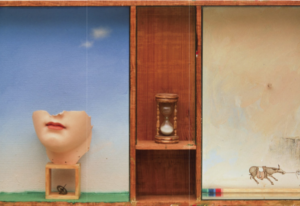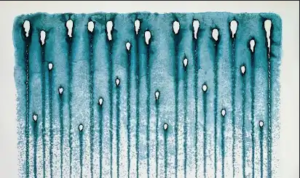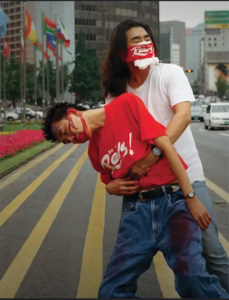The virtual exhibit I looked into is the National Museum of Modern and Contemporary Art in Seoul virtual exhibit on Korean Artists since the 1970. As someone interested in other cultures this was one that fascinated me. The exhibit showcased the art history of modern and contemporary art from the 1970s to the 2000s. The first work that got my attention is from Han Man-Young in 1987 titled, Reproduction of Time 87-7. Its dimensions are 51×90×10cm made with mixed media. The subjects you see are the bottom half of a venus head, an hourglass and a boy pulling a foal. Here we see Han borrow western classics and reconstruction. This is Korean Hyperrealism. The point in Korean hyperrealism is the emphasis of objects. It would depict these objects and then the landscape would be flat and endlessly sprawled. This created a juxtaposition. We can see it in this painting with the three objects and flat sprawled landscapes. Behind the venus head is an endless blue and behind the boy is a beige landscape. In the middle an hourglass. It looks like Han was trying to move through time. It is an interesting piece to look at. The weird realistic and flat objects alongside the flat landscape catched my attention.
The next piece I was interested in is Untitled by KWON Youngwoo in 1985.The materials used is white Korean paper blue-gray paint mixed with ink and Gouache. The Gouache is impregnated on the back of the paper in order to seep through. During this time many traditional artists used paper brush and ink, this was known as jipilmuk. The first use of the term “hangukwa” which means Korean painting. This piece caught my attention since it reminded me of abstract art of the west. Interesting enough a group Mungnimhoe (ink Forest Group) were the ones who introduced abstraction. They emphasize that abstraction was not exclusive to the west. I agree with this sentiment. It was cool to see what abstract artists in other countries and cultures were creating. I liked Untitled for its colors, the way the paint drips with streaks at the bottom and the Gouche that seeps through. Upon taking a closer look one can see the paint and the texture it creates on the paper.
Last piece is a color photograph Do Bring Seub by Jo Seub in 2002. It is a reenactment of the famous protest scene of Lee Hanyeol a victim of the 1987 June Democracy Movement. In the photo the artist is wearing a Red Devils soccer shirt and is bleeding from his head. Instead of just simply reproducing a historical movement it brings it up in a contemporary moment. In this case it was the deaths of two middle school girls by a US Army vehicle. This incident was buried due to the 2002 World Cup craze. Here the artist is critiquing the collectivist culture in Korean society and the 2002 World Cup is a symbol of that. The photograph caught my attention due the pose and colors. I also learned more about Korean history. The collectivism the artist is critiquing is something I heard a lot in many other East Asian countries. Meanwhile in America there are people who debate about individualism in western culture. It made me think that extreme collectivism and extreme individualism are both problems.
The virtual tour was fun to do. As someone who has gone to museums in person many times, both experiences are effective. In a virtual tour I was able to learn and look through the pieces just as well as in person. Since it’s online I can open other tabs and look things up. While I can do that in person if I have my phone with me, I am more likely to continue to the next piece quicker. It is also very accessible and more people may be willing to check things out since museums can seem overwhelming for some people. On top of that I can look into museums that I cannot go to because of my location. One con however, is that there is a stronger impression in being able to see the pieces in person. Other than that a virtual tour is effective.





